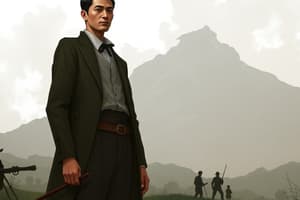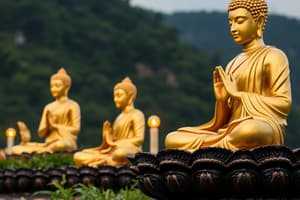Podcast
Questions and Answers
What was the proposed status of the Philippines under Spanish rule as part of the reforms?
What was the proposed status of the Philippines under Spanish rule as part of the reforms?
- The Philippines would remain under local governance.
- The Philippines would be assimilated as a province of Spain. (correct)
- The Philippines would become a colony without representation.
- The Philippines would gain independence from Spain.
What was one of the main reasons for the failure of the reform movement?
What was one of the main reasons for the failure of the reform movement?
- Strong support from Spanish officials.
- Lack of representation in the Cortes.
- Unity among the reformists.
- Absence of financial resources. (correct)
Who founded the secret association known as the Katipunan?
Who founded the secret association known as the Katipunan?
- Emilio Aguinaldo
- José Rizal
- Andres Bonifacio (correct)
- Apolonio dela Cruz
What was the governing body of the Katipunan called?
What was the governing body of the Katipunan called?
What role did the friars play in the reform movement?
What role did the friars play in the reform movement?
What was a significant consequence of the failed propaganda efforts?
What was a significant consequence of the failed propaganda efforts?
Which councils were established within the Katipunan to manage local governance?
Which councils were established within the Katipunan to manage local governance?
What incident led to the discovery of the Katipunan?
What incident led to the discovery of the Katipunan?
What initially drove Filipinos to armed resistance against the Spaniards?
What initially drove Filipinos to armed resistance against the Spaniards?
Which of these provinces did NOT have recorded resistance against Spanish rule?
Which of these provinces did NOT have recorded resistance against Spanish rule?
Why did many uprisings in the Philippines ultimately fail?
Why did many uprisings in the Philippines ultimately fail?
Which historical events inspired the emergence of nationalism among Filipinos?
Which historical events inspired the emergence of nationalism among Filipinos?
What contributed to the division among Filipinos during the uprisings?
What contributed to the division among Filipinos during the uprisings?
In terms of church positions, what controversy contributed to rising nationalism?
In terms of church positions, what controversy contributed to rising nationalism?
What was one of the implications of the liberal ideas spreading to the Philippines?
What was one of the implications of the liberal ideas spreading to the Philippines?
What was the primary purpose of the constitution framed by the Republic at Malolos?
What was the primary purpose of the constitution framed by the Republic at Malolos?
What role did native mercenaries play in the conflicts between Filipinos and Spaniards?
What role did native mercenaries play in the conflicts between Filipinos and Spaniards?
What event led to the United States declaring war on Spain?
What event led to the United States declaring war on Spain?
How much did Spain receive for ceding the Philippines to the United States?
How much did Spain receive for ceding the Philippines to the United States?
What was the official intent of the United States when it assisted the Filipinos against Spain?
What was the official intent of the United States when it assisted the Filipinos against Spain?
What form of government was established by the constitution of the Republic at Malolos?
What form of government was established by the constitution of the Republic at Malolos?
Which incident sparked the outbreak of the Philippine-American War?
Which incident sparked the outbreak of the Philippine-American War?
What did the assembly of representatives in the Republic at Malolos primarily function as?
What did the assembly of representatives in the Republic at Malolos primarily function as?
What was a common sentiment among some Filipinos towards the Americans after the Treaty of Paris?
What was a common sentiment among some Filipinos towards the Americans after the Treaty of Paris?
Who was the only president elected for a second term under the 1935 Constitution?
Who was the only president elected for a second term under the 1935 Constitution?
What type of government was introduced under the 1973 constitution?
What type of government was introduced under the 1973 constitution?
How long were members of the National Assembly elected for under the 1973 constitution?
How long were members of the National Assembly elected for under the 1973 constitution?
What was the purpose of Proclamation No.3 issued by President Corazon Aquino?
What was the purpose of Proclamation No.3 issued by President Corazon Aquino?
What significant event led to the issuance of Proclamation No.3?
What significant event led to the issuance of Proclamation No.3?
Which constitution was referred to as the 'Freedom Constitution'?
Which constitution was referred to as the 'Freedom Constitution'?
When was the 1987 Constitution ratified?
When was the 1987 Constitution ratified?
Which president's administration marks the transition into the Fifth Republic?
Which president's administration marks the transition into the Fifth Republic?
What was the primary outcome of the Spooner Amendment in the Philippines?
What was the primary outcome of the Spooner Amendment in the Philippines?
What significant change did the Philippine Autonomy Act of 1916 introduce?
What significant change did the Philippine Autonomy Act of 1916 introduce?
Which act was a precursor to the Tydings-McDuffie Act?
Which act was a precursor to the Tydings-McDuffie Act?
What legislative power did the Philippine Organic Act of 1902 vest in the Philippines?
What legislative power did the Philippine Organic Act of 1902 vest in the Philippines?
What was the main design of the Commonwealth government established by the Tydings-McDuffie Act?
What was the main design of the Commonwealth government established by the Tydings-McDuffie Act?
Which of the following acts promised independence to the Philippines after a specified transition period?
Which of the following acts promised independence to the Philippines after a specified transition period?
What was one important feature of the Tydings-McDuffie Act?
What was one important feature of the Tydings-McDuffie Act?
What significant governmental structure was replaced by the Commonwealth of the Philippines?
What significant governmental structure was replaced by the Commonwealth of the Philippines?
Flashcards are hidden until you start studying
Study Notes
Early Filipino Uprisings
- Filipinos resisted Spanish rule through armed rebellions in various locations, including Cagayan, Tondo, Cordillera, Cavite, Pangasinan, Leyte, Panay, Sultan Kudarat, and Mindanao.
- Cordillera and Moro communities successfully repelled Spanish forces, demonstrating effective resistance.
- Reasons for the failure of most uprisings include the Spaniards' superior weaponry and use of native mercenaries.
- Internal divisions and lack of unity, particularly due to the collaboration of powerful datus with the Spaniards, weakened the resistance.
Seeds of Nationalism
- Filipinos were inspired by liberal ideas from the American and French Revolutions, which demonstrated the possibility of overthrowing oppressive authority.
- The Secularization Controversy, aimed at replacing Spanish priests with Filipino priests in church positions, fueled the desire for greater autonomy.
The Propaganda Movement
- The Propaganda Movement advocated for reforms within the Spanish colonial system. Their goals included:
- Assimilation of the Philippines as a Spanish province, granting Filipinos full Spanish citizenship rights.
- Representation of the Philippines in the Spanish Cortes (legislature) to ensure equal legal status.
- Factors contributing to the failure of the Propaganda Movement:
- Spanish officials in the Philippines were preoccupied with internal issues and disregarded the reformists' demands.
- Lack of financial resources hampered the reformists' efforts.
- Internal divisions and jealousy among the reformists weakened their unity.
- The influence of friars, who opposed the reform movement, impeded its success.
The Katipunan
- The Katipunan, founded by Andres Bonifacio, was a secret society formed to achieve Philippine independence through revolution.
- The Katipunan adopted a structured form of government, including the Kataastaasang Sanggunian (Supreme Council), Sangguniang Balangay (Provincial Council), Sangguniang Bayan (Popular Council), and Sangguniang Hukuman (Judicial Council).
- Bonifacio and the Katipuneros actively spread their political ideals, gaining support from both the masses and some wealthy Filipinos.
Discovery of the Katipunan and the Cry of Pugad Lawin
- The premature outbreak of the revolution was triggered by the discovery of the Katipunan, likely due to a conflict between two members.
The Malolos Republic
- The Malolos Republic was the first to frame a comprehensive constitution, based on the principles of sovereignty residing in the people, basic civil rights, separation of church and state, and a parliamentary republic.
- The constitution called for an Assembly of Representatives to act as the legislative body and the election of a president for a four-year term.
American Intervention in the Philippines
- The United States' intervention in the Philippines was driven by its interest in acquiring colonies and its perceived need to protect its interests in the Pacific.
- Initial American promises of friendship were ultimately undermined by their imperialist ambitions.
- Tensions between Filipinos and Americans rose due to the USS Maine incident, a perceived Spanish attack that fueled American war fever.
The Treaty of Paris and the Philippine-American War
- Spain ceded the Philippines to the United States for $20,000,000, abandoning their colonial control.
- Despite American promises of independence, they aimed to establish their own colonial rule over the Philippines leading to conflict.
- The Philippine-American War began following an incident where American soldiers shot a Filipino soldier, marking the beginning of a new phase in Philippine history.
Politics in the American Period
- The United States established a military government in the Philippines, followed by a civilian government, culminating in the creation of the Insular Government.
- Key legislative acts shaping the Philippine government during this period:
- The Philippine Organic Act of 1902 established a bicameral legislature with the Philippine Commission (upper house) and the Philippine Assembly (lower house).
- The Philippine Autonomy Act of 1916, also known as the Jones Law, replaced the Philippine Commission with a Senate elected by Filipinos, creating the Philippines' first fully elected national legislature.
- The Hare-Hawes Cutting Act, though not ratified, promised Philippine independence after a 10-year transition period, setting the stage for the Tydings-McDuffie Act.
- The Tydings-McDuffie Act formally outlined the process for Philippine independence and the granting of a commonwealth status.
The Commonwealth Government
- The Commonwealth of the Philippines was a transitional government established by the Tydings-McDuffie Act to prepare the country for full independence.
- It served as an interim administration before the Philippines achieved full independence.
Martial Law (Fourth Republic)
- Ferdinand Marcos' presidency saw the adoption of a new constitution in 1973, introducing a parliamentary-style government.
- This constitution empowered a unicameral National Assembly with members elected for six-year terms, and the President was elected as a symbolic head of state chosen from amongst the members of the National Assembly.
The Fifth Republic
- The transition to the Fifth Republic was marked by the People Power Revolution, which ousted Ferdinand Marcos and brought Corazon Aquino to power.
- Aquino issued Proclamation No. 3, a provisional constitution that granted the President broad powers and paved the way for the drafting of a new constitution.
- The 1987 Constitution, also known as the "Freedom Constitution," replaced the 1973 constitution and marked the beginning of the Fifth Republic, which continues to this day.
- The Fifth Republic has seen a number of presidents, each influencing the political landscape of the country in their own way.
Studying That Suits You
Use AI to generate personalized quizzes and flashcards to suit your learning preferences.




